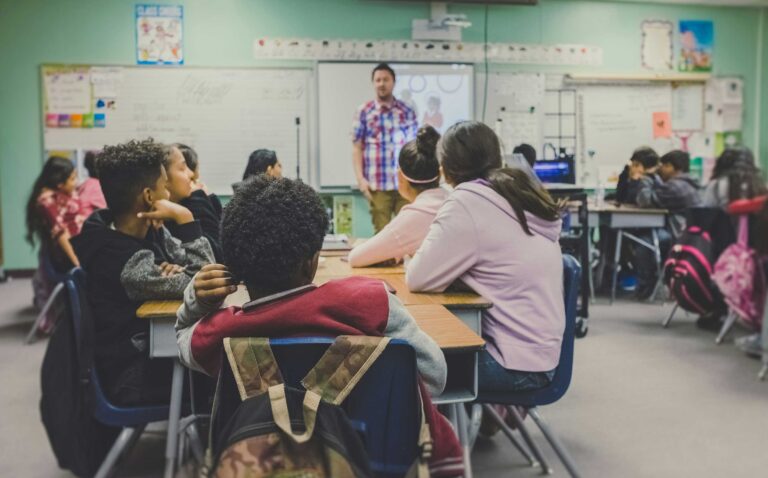Trauma is an emotional response to a distressing or disturbing event that overwhelms the individual’s ability to cope. Trauma is subjective – a traumatic experience for one person may not be traumatic for another, but that does not mean it is any less real for the person who is traumatized.
People of all ages experience trauma, but it has a particularly long-lasting impact on children as their brains are still rapidly developing. Often, children and adolescents don’t have the necessary coping skills to manage the impact of stressful events on their own or the language to explain their feelings (or even what happened).
WHAT DOES TRAUMA LOOK LIKE IN THE CLASSROOM?
There’s no one way for children and teens to respond to trauma, but here are some signs to look out for:
- Excessive anger or irritability
- Unusual startle reactions
- Significantly increased or reduced appetite
- Exhaustion
- Aggression (physical or verbal)
- Regular tardiness/absence from class
- Perfectionist or controlling behavior
- Difficulty concentrating
- Frequent headaches or stomachaches
- Low self-confidence
- Hoarding (snacks, school supplies)
- Risky behavior (substance use, sex)
- Panic attacks
- Extreme self-reliance or hyper-independence
- Running away
- Defiance
- Alienation from peers (self-isolation or inability to relate/make friends)
It’s important to keep in mind that trauma responses can vary by culture, race, gender, geographic location, and other factors – and students have all had different traumatic experiences over the last year. Many students and families may have dealt with vaccine anxiety, but likely not as intensely as Black Americans who thought back to the Tuskegee Study. In terms of trauma response behaviors, girls are more likely to turn inward and get quiet or retreat from social settings, while boys are more likely to get outwardly irritable or disrupt the class. All behavior is a form of communication – if a student’s actions or demeanor are disruptive or strike you as “off,” think about it from a trauma lens and consider what they might be trying to express as needs or wants.
Social-emotional Development: Experiencing trauma, especially at a young age, disrupts young people’s ability to relate to others and manage emotions. Without healthy coping skills, this often leads to poor in-class behavior, which can reduce learning time and increase rates of suspension and expulsion.
Academic Performance: Trauma can undermine many skills that are crucial for learning, including the development of language and communication skills, the ability to organize and remember new information, and reading comprehension. Students coping with trauma may experience intrusive thoughts or flashbacks that prevent them from paying attention in class, studying, or focusing during timed assignments. School-related trauma (like bullying or unfair punishment) often leads to school avoidance, leaving the most vulnerable students behind academically. Trauma also negatively impacts young people’s sense of self, making it difficult for those students to feel motivated, proud, and engaged in their learning.
If you notice these symptoms in a child or teen, you may want to consider or encourage a mental health screening. A screening is a free, anonymous, and confidential way to see if a person is showing signs of a mental health condition. Screening tools for young people and parents are available at MHAScreening.org. Once completed, screeners are given information about the next steps to take based on results.
Types of Trauma
It can be helpful to think about “big ‘T’ Trauma” and “little ‘t’ trauma.” Big ‘T’ Trauma is what most people think of when it comes to traumatic events – things like physical abuse or the sudden death of a parent. Little ‘t’ trauma refers to events that may not be as obviously traumatic but can still be too much for a child’s brain to process – things like parents fighting a lot at home or struggling to connect with peers.
Here are some issues that students may be struggling with this school year:
COVID-19:
The fear, uncertainty, and general upheaval that the pandemic caused has been (and continues to be) traumatic for many. Many youths are dealing with significant grief – over 1.5 million children have lost a primary or secondary caregiver due to COVID-19.1 Rates of substance use2 and family violence/abuse3 have increased during the pandemic, and even just heightened anger and arguing in the home can be traumatic.
RACIAL INJUSTICE:
In the U.S., Black, Indigenous, People of Color (BIPOC) students are vulnerable to racial trauma due to living in a system of white supremacy. Race-based discrimination and violence have been prominent in media coverage, which can be triggering and retraumatizing for students with marginalized identities.
SCHOOL FEARS:
The start of a new school year is often particularly challenging for students who have faced bullying or exclusion from their peers. A number of students may be dealing with severe separation anxiety after having spent more time at home recently, or if they saw less of their parent(s) during the pandemic due to essential work and fear that happening again.
SOURCES
1Hillis, S.D., Unwin, H.J.T., et al. (2021). Global minimum estimates of children affected by COVID-19-associated orphanhood and deaths of caregivers: a modelling study. The Lancet, 398(10298), 391-402.
2Abramson, A. (2021). Substance use during the pandemic. Monitor on Psychology, 52(2). https://www.apa.org/monitor/2021/03/substance-use-pandemic
3Usher, K., Jones, C.B., et al. (2021). COVID-19 and family violence: Is this a perfect storm? International Journal of Mental Health Nursing, 30(4). https://doi.org/10.1111/inm.12876


